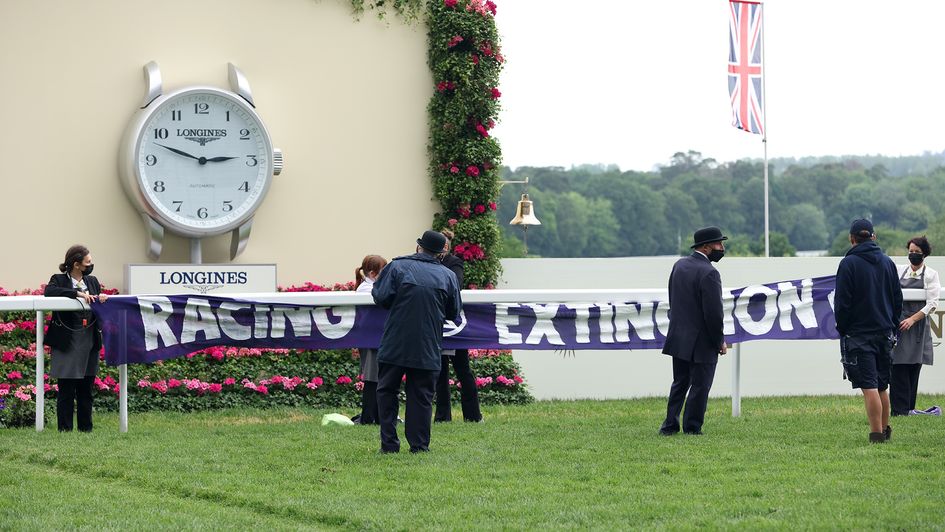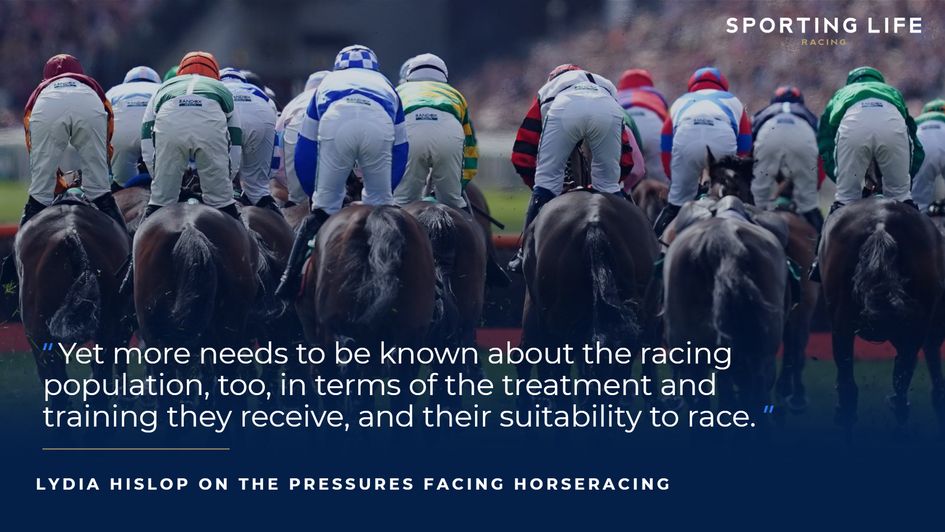That few people noticed Animal Rising’s attempt to invade Ayr racecourse on Saturday is confirmation the restless mainstream news cycle has already moved on from the ugly scenes at this year’s Grand National, perhaps sooner than many had feared.
Yet the sport of horseracing can’t just breathe a sigh of relief, again bury its head in the sand, and hope the general public will magically take its side.
The palpable sense of jeopardy generated must instead galvanise a strategy of tangible improvements and proactive messaging designed to reach the many, who occupy the reasonable and tolerant middle-ground in society. The sport and its fans deserve better than the 50-week dormancy from which successive industry leaders seem to wake each April for a belated rear-guard action directed against the zealot few.
Protestors may become a common sight at racecourses, albeit the fact no pink T-shirts were given air-time during ITV Racing’s coverage of the Scottish National could temper their enthusiasm. Members of the animal-rights group formerly known as Animal Rebellion – which holds close links to Extinction Rebellion, Just Stop Oil and Insulate Britain – vowed to make their Aintree protest “just the beginning” of a summer of action against horseracing and other common human practices they perceive to “exploit” animals.
Collectively, they’ve now targeted this sport on four occasions. Extinction Rebellion protestors unfurled a banner reading ‘Racing to Extinction’ at Royal Ascot in 2021. Minutes prior to last year’s Derby, six women wearing sashes branded 'Animal Justice’ ran onto the track at Epsom. Among them was Orla Coghlan, who in an editorially unbalanced slot on Good Morning Britain four days in advance of the National was given a platform to encourage “animal lovers” to join their Aintree protest, which ended in 118 arrests.

This ship has now definitively sailed
It's a widely held frustration among horseracing’s fans and participants that their sport is an easy target, inadequately understood and long lacking in effective public-facing advocacy with the effect that damaging misconceptions have been allowed to perpetuate.
The counter-argument (presumably, because we do not know for sure) favoured by successive industry leaders is engaging with extremists only draws attention to something that wouldn’t otherwise be an issue, as recently played out in the whip consultation process. This ship has now definitively sailed, however.
In that Good Morning Britain exchange, host Richard Madeley responded to Coghlan’s points with: “Factually, she’s right. Racehorses have to be put down. Sometimes they collapse and die. And they get whipped.” Former Daily Star editor Dawn Neesom, outlandishly and disastrously entrusted to supply the counter argument, began: "Factually, horseracing is not necessarily a good thing for animals."
Two days after the National on talk-radio station LBC, in a debate framed by the question “How can we continue justifying this massacre?", one caller cited a new rule permitting the whip to be used 16 times per race and claimed he'd counted one horse being whipped on 69 occasions in the National. The caller’s assertion went unqueried by the host, who admitted his ignorance of the wider subject and contributed his own inaccuracies. Later, again unchallenged, another caller referred to those 69 strikes as if they were fact.

These no longer count as extreme examples of the public conversation. Replicated to the nth degree online, this is how supposed knowledge is shared. So, the sport needs to ensure more people are better informed to challenge misinformation.
That neither the LBC host nor subsequent callers realised it was objectively preposterous that a highly regulated sport would permit such gross misuse of a riding aid is a damning indictment of its communication reach. As perhaps only ardent racing fans know, the whip can be used a maximum of seven times over Jumps and there were zero breaches of the tightened rules in the National.
Of course, nuance is not relevant to Animal Rising, whose ultimate vision is “a future where no animals are exploited, whether for food, fun, or any other purpose”. Their overarching demand to the UK government is the transition of all food production to a wholly plant-based system, and to rewild what they believe would be “freed up land” as a result. Racing can do nothing to persuade them.
The latest post on their website is a disparate series of emotive conflations and arbitrarily cited non-sequiturs entitled ‘Horse Racing: A Summary From Animal Rising’. Its author, for example, states: “In the wild, horses are free to move as they see fit, with studies finding that they can travel up to 28km each day. The BHS [British Horse Society] minimum recommendation for a standard horse stable is just over 13m squared, roughly twice the size of a single occupancy human prison cell in the UK."
Candid introspection alongside a more front-foot approach
The implication is clear – and with the glassy-eyed serenity of the utterly certain, a series of Animal Rising representatives pinned down in head-to-head interviews over the past fortnight have not denied it. They believe existing racehorses should be released into the wild or housed in sanctuaries, whilst the breed is phased out. Thoroughbred extinction – presumably along with any species that cannot survive without close human care – is one form of destruction Animal Rising doesn’t just tolerate but actively promotes.
Yet even though these activists are fanciful, wilful or specious in their arguments about thoroughbreds and their misunderstanding of the specialist care they require, it remains critical that the public hears a consistent, reasonable and evidenced response. Horseracing, and particularly the Grand National, is low-hanging but high-profile fruit to Animal Rising. It’s the sport’s urgent and existential task to change that – and it involves candid introspection alongside a more front-foot approach.
It's been striking that participants and fans of the sport already seem to have drawn greater confidence from the calm, consistent messages presented to the mainstream media in recent days – whether via the recently launched grassroots movement @StandUpForRacing, Jockey Club Racecourses chief executive Nevin Truesdale, or individual spokespeople, all using data provided by the British Horseracing Authority.
That British racing has reduced fatalities by a third in the past 20 years, and that 99.8% of 90,000 runners per year complete their races without fatality, are clear positive messages already gaining broad traction. Explaining how the sport seeks continually to minimise risk using scientific data is another key theme, and demonstrates its responsible self-regulation, guided by the independent welfare expertise of the Horse Welfare Board (HWB).
Horseracing must not be a pawn in the Culture Wars
The importance of the industry to society is also significant. The impact of horseracing to the British economy is £4.1 billion, providing direct employment for 20,000 people – including for those who find working with horses beneficial for their mental health – and indirectly for an additional 60,000. The sport has also invested £40 million in veterinary research and education that filters down to benefit all horses, not just thoroughbred athletes.
These factual arguments have been crucial in contextualising and countering the protestors’ one-track attack. However, it is important the sport is not drawn into the polarising controversy so beloved of politics in the mainstream. Horseracing must not be a pawn in the Culture Wars. It needs to evangelise the many, not alienate them via intemperate language, woolly thinking and intransigence.
Expounding the quality of life enjoyed by these elite equine athletes – and the word ‘athlete’ is more appropriate than saying they’re treated “like kings and queens” or “guests in a six-star hotel” – and the sport’s direct benefits to society versus Animal Rising’s ambition of thoroughbred extinction is not, in truth, difficult. It is not difficult to illustrate how animals stripped of a purpose are more likely to suffer a fate worse than death in actuality.

More needs to be known about the racing population
What is more problematic for the sport’s advocates is when the interrogatory scope is widened beyond a horse’s racing life.
If British racing wishes to harness this moment – and it must – to enhance the public’s understanding of, and potential empathy for, the sport, it must ensure its supporters’ efforts are not holed under the waterline by its own shortcomings. In the same way scientific analysis and objective data can both materially benefit the sport and crystallise a good-news message, its absence has the opposite effect.
When I was asked on Off The Ball what proportion of ex-racehorses enjoy a second career, I did not know the answer because the industry cannot yet account for all horses that cease to race. But I do know that whatever the answer might be, it needs to be better. So, the sport needs to take this work – its lifetime responsibility towards the thoroughbreds on which it relies – much more seriously, and put more money where its mouth is.
What happens to horses when they're no longer competitive in racing? Lydia Hislop explains.
— Off The Ball (@offtheball) April 17, 2023
🗣"That can be improved. It has been improved a great deal."
🗣"That is an area that horse racing needs to focus on."
🗣"They're actually really good candidates for a second career." pic.twitter.com/AB6L9uTD1M
Yes, British racing has made welcome advancements, and more money is in the pipeline for some of the initiatives discussed below. The post-racing safety-net has been expanded, with HEROS, the aftercare and retraining specialists appointed by the HWB and the Retraining of Racehorses (RoR) charity, supported to deliver an enhanced assessment-and-training programme. This scheme identifies, gathers data on, and funds the retraining of horses in need of additional support in their first steps away from their original role, thereby ultimately increasing the numbers taking this route. It needs better promotion.
Traceability has improved via the launch of the thoroughbred ePassport in 2019 and the introduction of the mandatory 30-day foal notification scheme for eligibility to race in Britain. The Thoroughbred Welfare Database – commissioned by the BHA and developed with Bristol University – was created in 2021 with the ambition of reducing data gaps on all registered thoroughbreds. This will be integrated with the RoR database to help inform the aftercare status of retired racehorses.
Yet more needs to be known about the racing population, too, in terms of the treatment and training they receive, and their suitability to race. Population studies would enable the sport to make better, more informed decisions, and promote enhanced health, care, husbandry and disease control.
Funding for the Jump Racing Risk Model – a powerful data hub that will be used to identify trends across the sport and improve equine safety via risk-analysis, now supported by the Royal Veterinary College’s independent experts in epidemiology – has also been secured from the Racing Foundation, the sport’s charitable resource. This work will continue to target reasonably avoidable injuries and fatalities, even though marginal gains in this area become proportionately harder as more success is achieved.
Increased funding, thought and time also urgently needs to be assigned to the effective communication of these advances, translating what can be a baffling series of acronyms and dry theory into the actual benefits they bring for the thoroughbred. Only by doing this more widely, effectively and consistently will public trust in the sport be maintained and grow. Great British Racing (GBR), the sport’s official marketing and promotional body, does some good work but – again – more must be done.
For example, GBR’s National Racehorse Week initiative provides an invaluable access point for the public to make their own minds up about the sport. Its training-yard open days reach a cross-section of people the sport would love to see more often. In 2022, 40.4% of attendees to the week-long events described themselves as “having little-to-no knowledge” of racing and 19% were “new to racing”. 87% of the total attendees reported that their visit had “positively changed their opinion of racehorse care".
British racing needs a different strategy to address what, unattended, has the potential rapidly to become an existential issue. It needs to consider whether late net advances were eventually made from engaging more directly during the past fortnight. Whilst there is clearly a balance to be struck rather than weighing into every quarrel, the debate is happening anyway. If the sport won’t stand up for itself, who will?
More from Sporting Life
- Racecards
- Fast results
- Full results and free video replays
- Horse racing news
- Horse racing features
- Download our free iOS and Android app
- Football and other sports tips
- Podcasts and video content
Safer gambling
We are committed in our support of safer gambling. Recommended bets are advised to over-18s and we strongly encourage readers to wager only what they can afford to lose.
If you are concerned about your gambling, please call the National Gambling Helpline / GamCare on 0808 8020 133.
Further support and information can be found at begambleaware.org and gamblingtherapy.org










